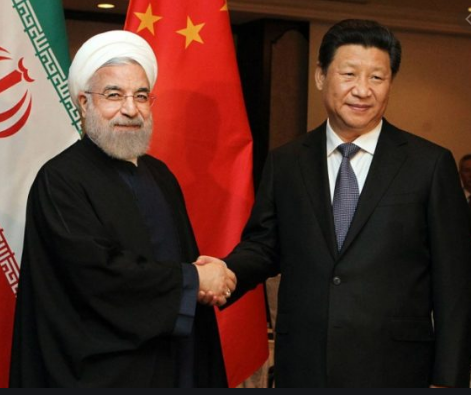By Hassan Mahmoudi | July 19, 2020

Sanctions imposing maximum pressure on the clerical regime, backed by internal economic crises, have laid the ground work for the regime’s fears of civil unrest; the people’s dire economic situation leaves them with nothing to lose. The stress on the mullahs has also provoked infighting at the top of the regime.
To find a light at the end of this dark tunnel, the regime intends to tie up with China and Russia, to take advantage of their international and political potential, to break its economic deadlock and to block any potential uprising.
On July 12, speaking at the National Security and Foreign Policy Commission’s session in the Majlis (parliament), the Iranian regime’s foreign minister, Javad Zarif, said: “When MR. Xi Jinping visited Tehran in 2015 and met with Khamenei, this was the overture for the 25-year cooperation accord.”
Mesbahi Moghadam, a member of the Iranian regime’s Expediency Council, shed light on the role of the Iranian regime Supreme Leader Ali Khamenei in this sell-out deal involving the transfer of Kish Island, along with military and intelligence cooperation between the regime and the Islamic Revolutionary Guards Corps (IRGC) and the Chinese government, saying: “The 25-year cooperation document with China went through after (Khamenei) sent a special message and a special messenger (to China) and met with the Chinese President.”
He said the deal was to remedy the regime’s turmoil and added: “Today, our situation forces us to inject more hope into the society. If hopelessness prevails, there could be social riots. In this regard having relations with China and Russia can provide paths to new opportunities”
Tehran also intends to use this concession to China as a tool to block the extension of the UN arms embargo which will be voted on by the United Nations Security Council (UNSC) in September of this year, by using China and Russia as vetoing countries. On the other hand, China uses this deal to have privilege over the US regarding trade agreements.
Simon Watkins, a British economic journalist, highlights the security aspect of this document and writes: “Another element that will change the entire balance of geopolitical power in the Middle East has been added to the deal. Last week, the Supreme Leader [Ali Khamenei] agreed to the extension of the existing deal to include new military elements that were proposed by the same senior figures in the IRGC and the intelligence services that proposed the original deal, and this will involve complete aerial and naval military cooperation between Iran and China, with Russia also taking a key role.” One of the Iran sources told OilPrice.com last week that part of the new military cooperation includes an exchange of personnel between Iran and China and Russia, with up to 110 senior Iranian IRGC men going for training every year in Beijing and Moscow and 110 Chinese and Russians going to Tehran for their training.
In this document, China is introduced as ‘the permanent Iran oil buyer’. The Iranian regime will sell its oil, gas, and petrochemical products to China 12% cheaper than the market price. It also grants China a double discount of 6-8%. Accordingly, China will be buying Iran’s oil products at least 32% cheaper than their true value at global markets.
More than an economic deal, this is a military deal to preserve the Islamic Republic from its downfall. The regime is not able to buy military equipment and no country is allowed to sell such equipment to Iran. This agreement will grant unlimited access to Iran’s bases for Russian and Chinese military forces and they will also have permission to transfer advanced military equipment into Iran.
A local from Isfahan said: “To this regime, national interest is not important. It just thinks of its own survival. It is our nation’s duty to rise and act and stop this deal with our protests.”
A citizen from Shiraz said: “This deal with China is much worse than the Turkman Chai Deal in 1828 and the Golestan Deal in 1813 which they wanted to impose on Iran in two wars with the Russian tsar.”
But for the people of Iran this does not come as a surprise; they have the experience of 41 years of treachery by this regime against their anti-monarchy revolution, of suffering from torture, execution, and murder as well as seeing the country’s resources and assets squandered. For years the people have distanced themselves from this regime and expressed their abhorrence of it by street protests and years of uprisings. They do not see their hopes and future in this regime and its agenda.
Amid the coronavirus spread, the mullahs’ regime hoped the voice of protest would be hushed. But, both in Iran and abroad, this voice is rising again.
Iranian patriots living outside the country staged their annual international conference on July 17 in support of human rights and the protests of the Iranian people. Over a thousand MPs, politicians and distinguished international dignitaries participated in this virtual global summit, thereby expressing their support for the people of Iran and many spoke, clearly and firmly aligning themselves with the desire and will of the people of Iran for a free, secular, democratic country at peace with the world and its neighbors and pledging to do everything they could to help them bring this to reality.
In this context we must trust that reaching out to China will prove to be too little too late for the regime’s survival.
- Thaçi Says War Crime Indictments Are Efforts Against Kosovo’s Freedom [1]
- Iran: Zarif’s speech In Parliament A Showcase Of The Regime’s Dead-End [2]
This piece originally appeared on Tsarizm.com [3] and is used by permission.